
-
Find the right food for your petTake this quiz to see which food may be the best for your furry friend.Find the right food for your petTake this quiz to see which food may be the best for your furry friend.Featured products
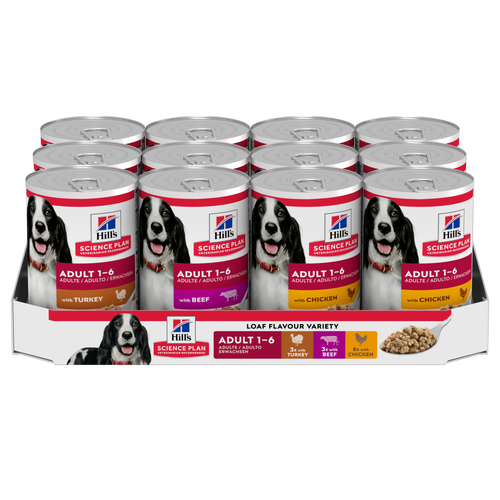 Adult Wet Dog Food with Beef
Adult Wet Dog Food with BeefHill's Science Plan Adult Multipack Wet Dog Food with Chicken, Beef & Turkey are complete premium pet foods for adult dogs from 1 year. Your dog will love these deliciously smooth and savoury minced loaves, formulated for balanced nutrition and overall health.
Shop Now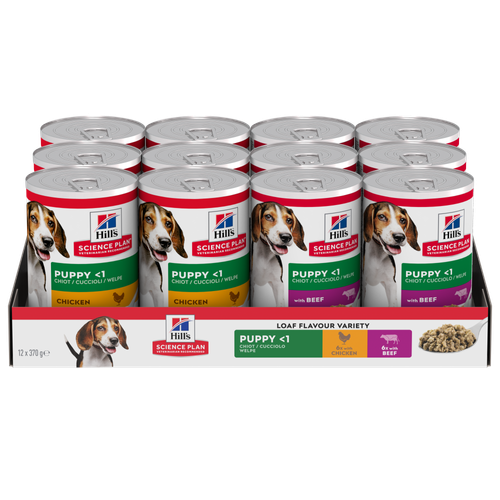 Puppy Food
Puppy FoodHill's Science Plan Puppy Multipack Wet Dog Food with Chicken & Beef are complete premium pet foods for growing puppies from weaning until 1 year old and for pregnant and nursing dogs. Your puppy will love these deliciously smooth and savoury minced loaves, formulated for balanced nutrition and overall health.
Shop Now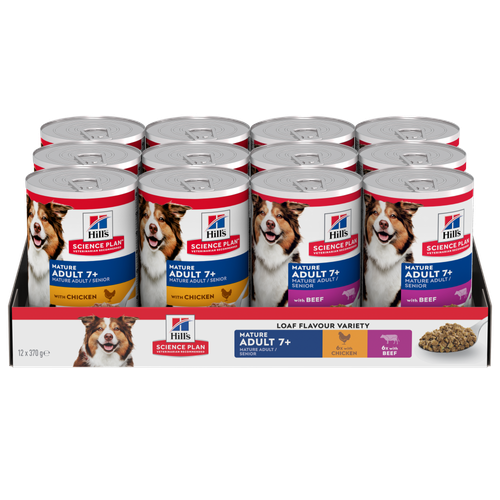 Mature Adult Dog Food
Mature Adult Dog FoodHill's Science Plan Mature Adult Multipack Wet Dog Food with Chicken & Beef are complete premium pet foods for mature adult dogs from 7 years. Your dog will love these deliciously smooth and savoury minced loaves, formulated to deliver the appropriate amount of energy to support the needs of adult dogs.
Shop NowFeatured products Sensitive Stomach & Skin Adult Cat Food
Sensitive Stomach & Skin Adult Cat FoodHill's Science Plan Sensitive Stomach & Skin Adult Wet Cat Food with Turkey is a complete pet food for adult cats, aged 1–6 years. This highly digestible wet food comes in a pouch and supports healthy digestion, as well as nourishes skin and promotes a thick and lustrous coat.
Shop Now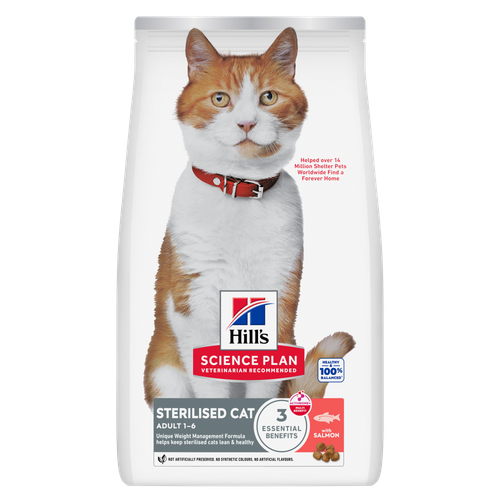 Sterilised Adult Cat Food
Sterilised Adult Cat FoodHill's Science Plan Adult Sterilised Cat Dry Food with Salmon is specially formulated with ActivBiome+ Multi-Benefit Technology. It is a precisely balanced nutrition, tailored to meet the needs of sterilised cats, to help keep them lean & healthy.
Shop Now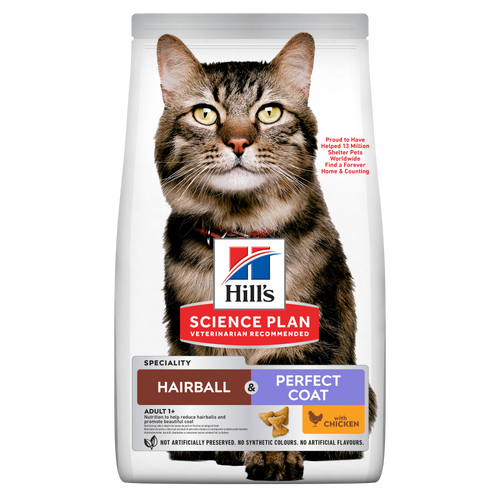 Hairball & Perfect Coat Adult Dry Cat Food with Chicken
Hairball & Perfect Coat Adult Dry Cat Food with ChickenHill's Science Plan Hairball & Perfect Coat Adult Cat Food with Chicken is formulated to effectively help avoid hairball formation in adult cats while promoting a beautiful coat. Thanks to its mix of essential omega-6 fatty acids, this food benefits the cat's skin and fur, keeping them healthy and shiny. Our Advanced Fibre Technology helps reduce hairballs by naturally promoting their passage through the gut. This food is formulated with high-quality protein for a perfectly balanced, great-tasting recipe.
Shop Now -
Dog
- Dog Tips & Articles
-
Health Category
- Weight
- Food & Environmental Sensitivities
- Urinary
- Digestive
- Joint
- Kidney
-
Life Stage
- Puppy Nutrition
- Adult Nutrition
- Senior Nutrition
Cat- Cat Tips & Articles
-
Health Category
- Weight
- Skin & Food Sensitivities
- Urinary
- Digestive
- Kidney
-
Life Stage
- Kitten Nutrition
- Adult Nutrition
Featured articles The Right Diet For Your Pet
The Right Diet For Your PetIn people, the right diet is very important. If you are eating the wrong way for your metabolism, activity level, age and lifestyle you could end up with health issues.
Read More Show some love with wet foods: a great choice for pets with health issues
Show some love with wet foods: a great choice for pets with health issuesShow some love with wet foods: a great choice for pets with health issues.
Read More The Incredible Science Behind Your Pet's Microbiome
The Incredible Science Behind Your Pet's MicrobiomeLearn what your pet's microbiome is, how it contributes to your pet's gut and overall health, and why nutrition is important in maintaining healthy microbiomes.
Read More -


You probably know some humans who deal with dandruff, but did you know dogs get dandruff, too? You may have noticed your pup scratching more often or seen white flakes on their bedding. Besides irritated skin, these signs can also point to a skin condition called walking dandruff.
When should you visit your vet for your dog’s dandruff? Since the signs of canine dandruff can be very similar to other skin issues, it's important to know what to watch out for and the possible treatment options to consider.

The Facts About Dog Dandruff
Dandruff is the presence of dead skin cells on your dog's coat. Depending on the colour of your dog's fur, it may be difficult to actually see the flakes, but they are often visible when they hop off the couch or put their head in your lap.
There are many ways a dog's skin can get irritated. From excessive licking to a nutritional issue, the root cause of dandruff can sometimes be difficult to identify. The first thing to ask yourself is whether you notice the dandruff all over your pup's coat or just in a particular area. Irritated skin in one concentrated spot could be due to a reaction to something your dog came in contact with, or it could be a more serious problem like an infection or parasite. Once you notice dandruff, consider visiting your vet for help. If you notice additional signs such as itching, reddened skin, irritation, or scaly patches of hair loss, then the best advice would be to consult with your vet immediately for further help. Since skin issues can have genetic, environmental, nutritional or parasitic causes, sometimes several different treatment options have to be explored.


Tasty Tips
Preventing & Treating Dandruff
There are a few things you can do to prevent dog dandruff and other skin problems. Blue Cross recommends that pet parents start by grooming their dogs regularly. Frequent brushing removes matted hair, leaves less of a breeding ground for parasites, and helps to stimulate the natural oils in the skin and fur. It also gives you the chance to spend a few minutes checking your dog for any unusual lumps, bumps, fleas, ticks and other potential issues.
Your vet might suggest bathing your dog more frequently to prevent dandruff. If you’re going to use a shampoo, the PDSA advises asking your vet to recommend one specially formulated for dogs. Make sure you dry your pet thoroughly after their bath, too.
If simple preventative measures like grooming and bathing are not getting rid of your dog’s dandruff, discuss special food options or intolerance tests with your vet. They can help you find a dog food with ingredients like omega-3 fatty acids and vitamin E that promote a healthy coat and immune system.

The Difference Between Dandruff and Walking Dandruff
A more serious possible cause for your dog's flaky, itchy skin is a condition called walking dandruff. The Kennel Club UK clarifies that walking dandruff is a parasitic infection called cheyletiellosis that is caused by mites. The Kennel Club notes that walking dandruff doesn’t typically cause itching, with the main sign being what seems like excessive dandruff. The condition is extremely contagious and can be easily spread to other pets in your household like cats and rabbits, so it’s important to see your vet as soon as possible.
Unfortunately, there is no quick fix for walking dandruff. Your vet will likely administer a topical treatment called a dip that coats your dog's fur in a mite-killing medicine. Dips and other treatments may need to be repeated once or twice every week for up to six weeks. You should also bring any other household pets to the vet for mite treatment, and you may need to treat your home with a pesticide designed for killing mites and fleas.
No one likes to see their pup itchy and uncomfortable. Once their dandruff or other skin issues are addressed, hopefully you and your dog can enjoy more time doing the things you love, itch-free.


Chrissie Klinger is an educator, writer and mother of two children, three dogs and three cats. Her dog Jake loves sitting on her lap every chance he gets! She enjoys living an active and eco-friendly lifestyle in rural Pennsylvania.
Related products

Hill's Science Plan Puppy Multipack Wet Dog Food with Chicken & Beef are complete premium pet foods for growing puppies from weaning until 1 year old and for pregnant and nursing dogs. Your puppy will love these deliciously smooth and savoury minced loaves, formulated for balanced nutrition and overall health.
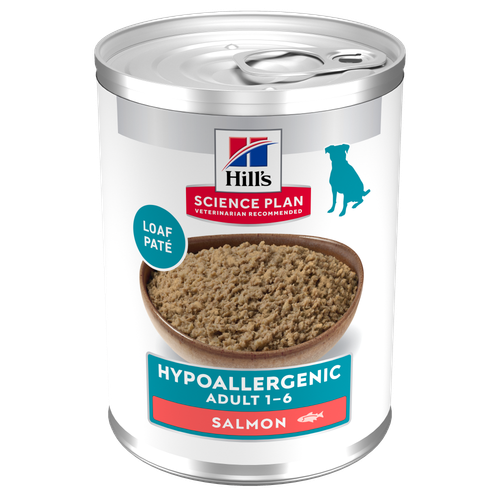
Hill's Science Plan Hypoallergenic Adult Wet Dog Food with Salmon is a complete premium pet food for all adult dogs from 1 year. This savoury tinned loaf is specially formulated for dogs with delicate skin and stomachs. It features a single novel animal protein source and is grain-free.

Hill's Science Plan Mature Adult Multipack Wet Dog Food with Chicken & Beef are complete premium pet foods for mature adult dogs from 7 years. Your dog will love these deliciously smooth and savoury minced loaves, formulated to deliver the appropriate amount of energy to support the needs of adult dogs.

Hill's Science Plan Adult Multipack Wet Dog Food with Chicken, Beef & Turkey are complete premium pet foods for adult dogs from 1 year. Your dog will love these deliciously smooth and savoury minced loaves, formulated for balanced nutrition and overall health.
Related articles

How, when and what to feed your new puppy is an important decision, learn more about the things to consider for feeding your puppy.

Learn effective tips for feeding a dog that's a picky eater and ensure proper nutrition for a finicky eater. Discover tips for pet parents at Hill's Pet UK.

Many human foods are dangerous to dogs. Read about 5 of the worst toxic food offenders that can kill your dog - and how much it takes to hurt them.

Learn about the potential health risks of a raw diet for dogs and why they aren't the best option for your pup or you.

Put your dog on a diet without them knowing
Our low calorie formula helps you control your dog's weight. It's packed with high-quality protein for building lean muscles, and made with purposeful ingredients for a flavourful, nutritious meal. Clinically proven antioxidants, Vitamin C+E, help promote a healthy immune system.
Put your dog on a diet without them knowing
Our low calorie formula helps you control your dog's weight. It's packed with high-quality protein for building lean muscles, and made with purposeful ingredients for a flavourful, nutritious meal. Clinically proven antioxidants, Vitamin C+E, help promote a healthy immune system.

